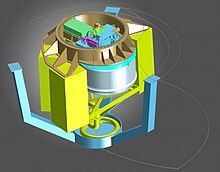3D Modelling




This learning resource support authors in Wikiversity to provide 3D models in learning modules. Furthermore this module can be used for learners themselves to create web-based 3-D models. The course focuses on web-based three-dimensional models, because they how to be accessible directly by a link in the Wikiversity content.
History
[edit | edit source]The learning resouces follows the Open Community Approach and therefore the used software is Open Source and the course is setup up in Wikiversity, so that the community of learners can learn, modify and extend the learning resource. All tools presented in this course Open source tools, they are freely accessible for learners.
Learning Objective
[edit | edit source]The course is based on two major steps: See and explore web-based models and create your own three-dimensional models if you decide they are useful for you learning module in Wikiversity.
- Explore 3D Models: Learn, what you can do with 3D models in a browser.
- Create 3D Models: Learn, how to Create 3D your own models with OpenSource tool.
- 360 Degree Video as realistic background video in 3D models
- Projective Geometry Projective geometry introduces to the workflow from objects in the 3D space into the twodimensional plane.
- Photogrammetry addresses the opposite workflow from multiple twodimensional images towards a 3D model.
Subtopics
[edit | edit source]- 3D Scan - use scanning devices to create 3D Models of an object
- Photogrammetry[2] - Take a snapshot of an object from different angles and generate a 3D Model with software (e.g. OpenSource Regard3D)
- Perspective Drawing on a Mirror with Geogebra
- Geographic Terrains
- 3D Interior Design
- 3D Models in Mathematics
Learning Task
[edit | edit source]- (Your first 3D Model of a Cup) Perform the Blender Cup Tutorial!
- (Screencasting) Learn how to create a Screencast[3] with Open Broadcasting Software (OBS)!
- (Train the teachers) Create your own learning video and share your results on Wikiversity!
- Export the Cup as GLTF model in blender and place your cup on a marker with AR.js.
- (3D Models and OER) Analyse the options for 3D-Printing for sharing learning material as Open Educational Resources.
- (Computer-Aided Design - CAD)
- Explain why and how computer-aided design needs a 3D modelling infrastructure.
- Describe different pathways to create a non-digital objects from a digital 3D model (small objects in 3D printer, print houses, mirco, nano scale, ... - include also cost efficience and required number of mockups and prototypes for the design process).
- Compare transport of non-digital products with a transport of digital 3D model over the internet and a 3D print at the location where the product is needed.
- Space agencies plan to land on Mars and pay-load to other planets is extremly costly. Sending a digital 3D model from on planet to another planet and produce the product from the 3D model is an other alternative. Compare those approaches for space traffic management and transfer the setting to applications on earth (e.g. printing required resources in an emergency case in remote areas, where transport of non-digital resources would take much more time.
- Design a passenger cell for Intermodal Public Transport and create a Blender animation that shows Interoperability in a 3D model. Show the process from a idea to an animated 3D model, which shows how a passenger enters a kind of box (passenger cell) and the passenger cell changes its propulsion unit, e.g. electro vehicle from home, connect the passenger cell with the drone thats transport the passenger cell to bus with a trailer with several passenger cells on it and finaly the passenger cell is carried by an aeroplane to the final destination. What are the required modelling elements that you need. Plan the animation with a storyboard.
See also
[edit | edit source]- 2D Animation
- Blender (software)
- Real World Lab
- TrackingJS - tracking of objects in a webcam and videos just with JavaScript
- Stereoscopy
- Photogrammetry
References
[edit | edit source]- ↑ ERIS Project Starts - http://www.eso.org/public/announcements/ann13054/ - (accessed 2013/06/14) newspaper ESO Announcement
- ↑ Mikhail, E. M., Bethel, J. S., & McGlone, J. C. (2001). Introduction to modern photogrammetry. New York.
- ↑ OBS Tutorial: Open Broadcaster Software - Screencast/Video Screen Capture (OBS Studio/Multiplatform) by TanUv90 (2016) - https://www.youtube.com/watch?v=qeDNgLBVPLU (accessed 2018/01/11)
